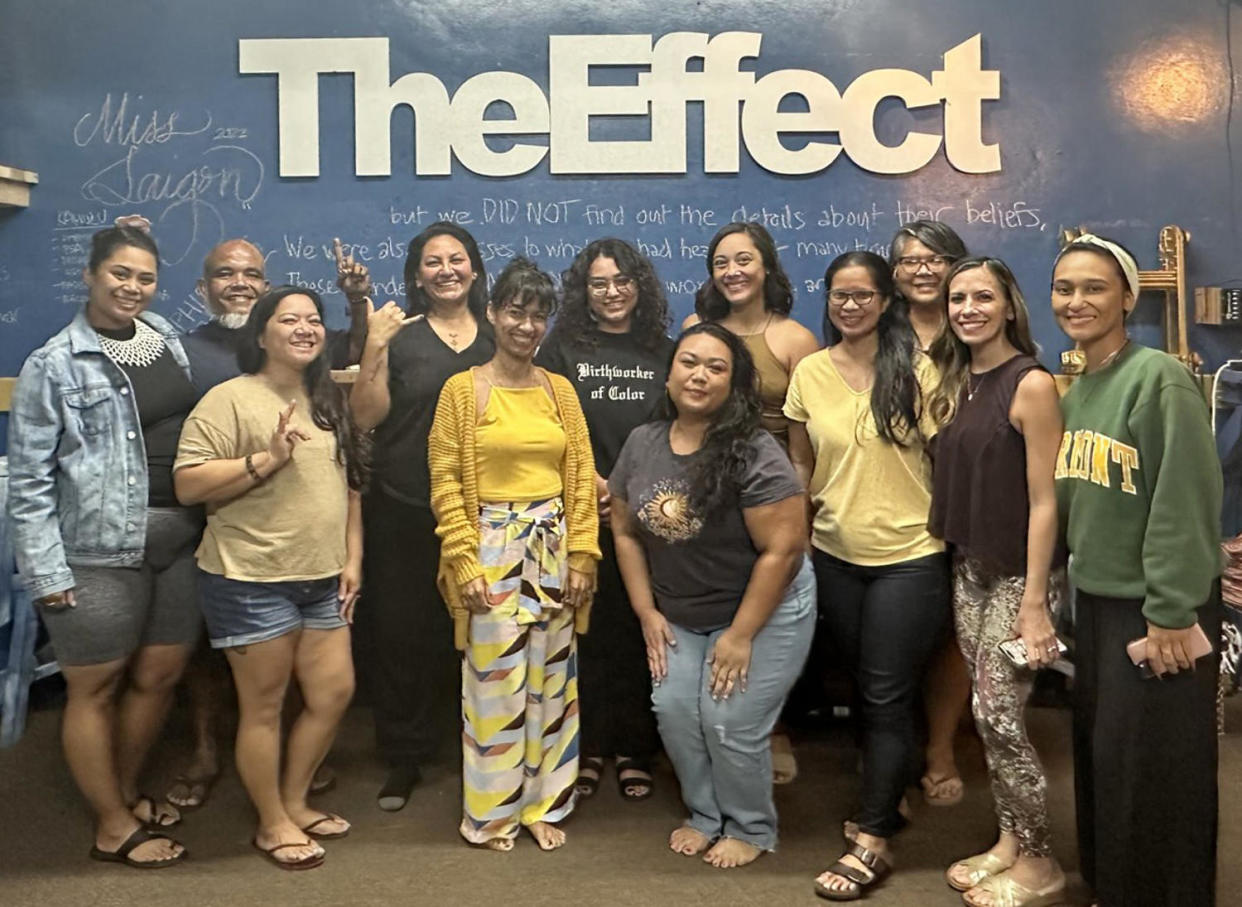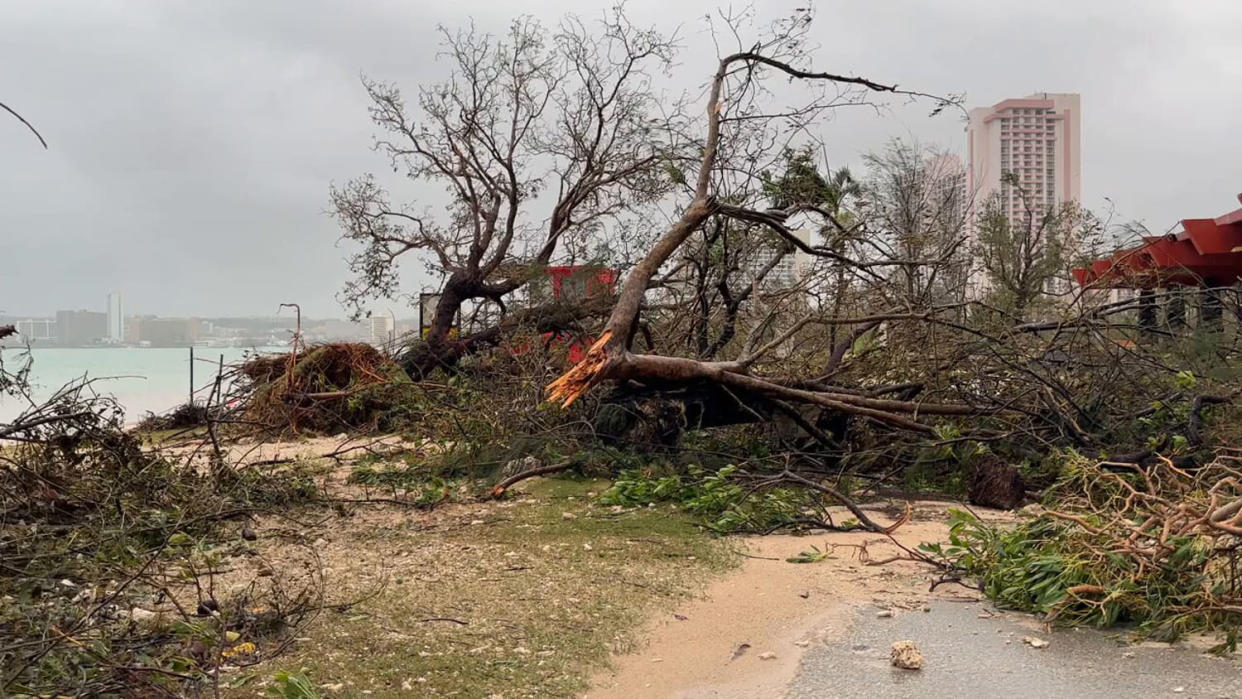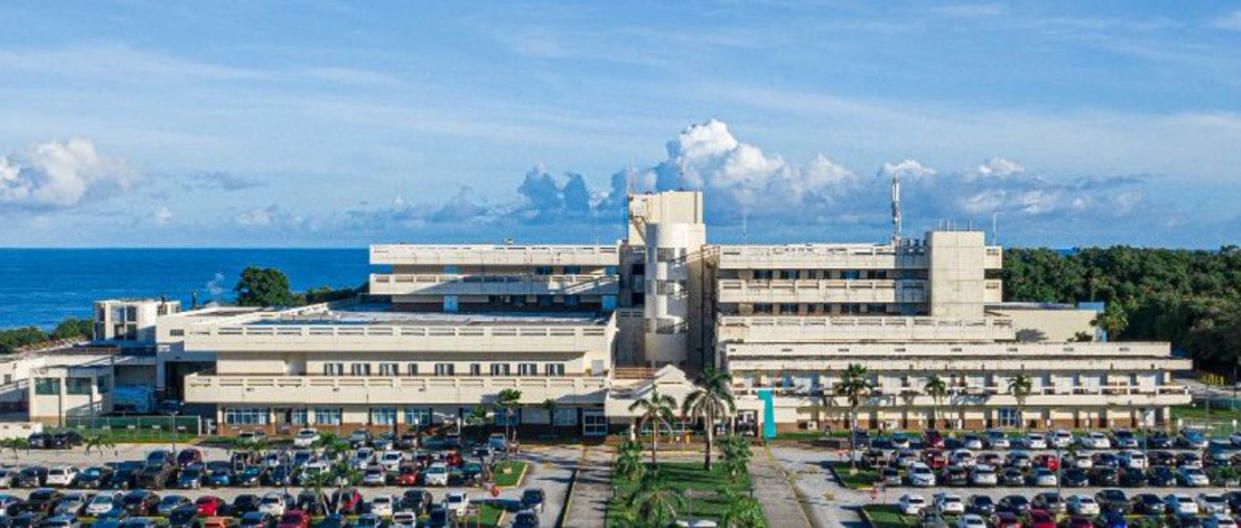Indigenous doulas lead the fight for reproductive care access gap in Guam
On the day Livia Marati was due to give birth, Typhoon Mawar barreled toward Guam. Anyone more than 36 weeks pregnant was instructed by the governor’s office to make their way to the island’s only hospital with their own linens and drinking water. Family members had to stay behind.
Marati, a 35-year-old CHamoru woman, ran worst-case scenarios through her head: What if a tree was blocking the road to the hospital? Or the power went out? “I called my doula just in case I needed to give birth over the phone,” she said.
Thankfully, she ended up giving birth at Guam Memorial Hospital a few weeks later, after electricity had mostly been restored on the island. But the close call was a reminder of the fragility of emergency services for birthing people without access to a doula. “For the wider population here, they don’t have support or an alternate plan in place,” Marati said.
For the past two years, medical professionals have been sounding the alarm for what they consider a “maternal care crisis” on Guam. After the closure of the island’s only standalone birth center in December 2022, Guam’s maternity support options are the single hospital and the one doula who helped Marati. Though many U.S. states are starting to reimburse doula care through Medicaid, that coverage doesn’t extend to U.S. territories like Guam. The island has also been without abortion services since the only abortion-providing doctor retired in July 2018.
A CHamoru women-led organization is trying to fill these reproductive access gaps. By training CHamoru doulas, the Birthworkers of Color Collective is preparing women on the island for the increasing frequency of climate disasters like Typhoon Mawar, which struck last spring. On heavily militarized, resource-strapped Guam, the collective is hoping to equip the community with Indigenous-centered reproductive practices and rapid-response birthing support.

“When Americans talk about reproductive access and rights, they’re not thinking about how territories like Guam are doubly, triply impacted by laws and decision-making,” said Stevie Merino, the 35-year-old CHamoru founder of the Birthworkers of Color Collective. “Reproductive justice is not just the birth experience, it’s also about climate injustice, food insecurity and affordable housing.”
Climate change has exasperated Guam’s reproductive access issues
A 2022 Intergovernmental Panel on Climate Change report found that pregnant women were more likely to suffer disproportionately during extreme climate events. In Guam — where maternal mortality and infant mortality rates are higher than the national average and CHamoru infants are five times as likely to die before age 1 — a critical care nurse at Guam Memorial Hospital testified at a legislative hearing last year that another supertyphoon could shut down the hospital’s outdated facilities, leaving pregnant people completely stranded with nowhere to go.
Lack of reproductive access is compounded by environmental and cultural issues stemming from the region’s history and strategic location. When Guam was under Spanish rule from 1521 to 1898, the CHamoru population decreased by 90%. The island was ceded to the U.S. in 1898 following the Spanish-American War, captured by the Japanese in 1941, then recaptured by the U.S. in 1944, leading to the environmental destruction of one-third of the island that has come under U.S. military control. Guam and the nearby Marshall Islands have elevated rates of infertility, miscarriages and birth complications due to high levels of nuclear waste and radiation from military testing. Since the retirement of Guam’s only abortion-providing doctor in 2018, women now must rely on telemedicine shipped from Hawaii if they choose to have an abortion.
For over 4,000 years, traditional CHamoru healers practiced and passed down their knowledge — until they were attacked by the Catholic Church for practicing voodoo. “On Guam, we had Suruhano healers — people who knew how to work with plant medicine for pregnant bodies and babies,” Merino said. “After World War II, our island was heavily militarized, and healers and midwives were regulated or outlawed by the military government.”
Merino explained that birthing only became a medicalized process within recent decades. “Younger generations are trying to reclaim traditional healing practices, but many practices were lost because they weren’t passed down,” she said. “That’s why our doula training feels especially timely now.”
Recentering Indigenous practices through doula training
Merino, who is based in Long Beach, California, first had the idea to organize a full-spectrum doula training — which covers all pregnancy and postpartum outcomes — in Guam right before Typhoon Mawar hit last year.

“I knew that folks needed more rapid response birthing skills,” Merino said. “We needed more doulas in the community who could support people.”
Merino was quickly able to secure grants from reproductive justice organizations for a doula training on the island. News of the training spread via social media and word of mouth, and 17 participants, mostly CHamoru, signed up for the three-day intensive in December.
Tia Muña Aguon, a 33-year-old Guam native, heard about the training through Instagram. “Unless you’ve grown up around it, traditional birthing practices are most likely lost in your family,” Aguon said. “It was important that we could hear from elders, who could tell us what our ancestors did.”
Marati added that centering Indigenous birthing knowledge was a way of honoring what her ancestors might have done only a few generations ago. “It felt like a remembrance of something that we know inherently — to support women in this way,” she said. “The elders shared their knowledge with us so we can carry it on in the birthing world.”
Because the three-day doula training covered all aspects of birthing — prenatal pregnancy, labor and delivery, abortion and miscarriage — the doulas-in-training were encouraged to explore what they were drawn to.
Some attendees were surprised to find that they felt the urge to tackle a taboo and become abortion doulas. “The island is very rooted in Catholicism,” said Gilayna Santos, a former Guam Pacific Daily News editor who attended. “The stigma around the choice [to get an abortion] is very charged. Many women have had to make the choice out here, but they don’t talk about it.”
Santos, 34, said that when she found out she was pregnant in 2014, family members shamed her into thinking God would punish her if she had an abortion. Her saving grace was an older woman who talked her through her options non-judgmentally. Santos hopes to do the same for other women and even go a step further — be present with them during the actual procedure. “What I really wish I got that I didn’t was the actual person in the room,” Santos said. “It’s so important to have another person there advocating for you, when you’re in the middle of such an intense experience.”
The future of doulas in Guam

The 17 doulas in training are now finishing an online course on maternal mental health, lactation and Pacific Islander postpartum traditions. Because of continued interest, Merino is planning another full-spectrum doula training in Guam for May and hopes to set up more trainings on nearby islands.
In the meantime, doulas like Marati and Aguon are already offering their services on the island. When Aguon showed up to support her first client’s birth at Guam Memorial, the nurses asked her in the hospital recovery room about the purpose of a doula. “There’s a missing link there,” Aguon said. “Having a doula isn’t normalized and understood in Guam.”
But she hopes to slowly change that. “As a doula, I just want to stand as an educator and an advocate, so that the mothers themselves are empowered to follow their intuition and make their own choices,” Aguon said.
